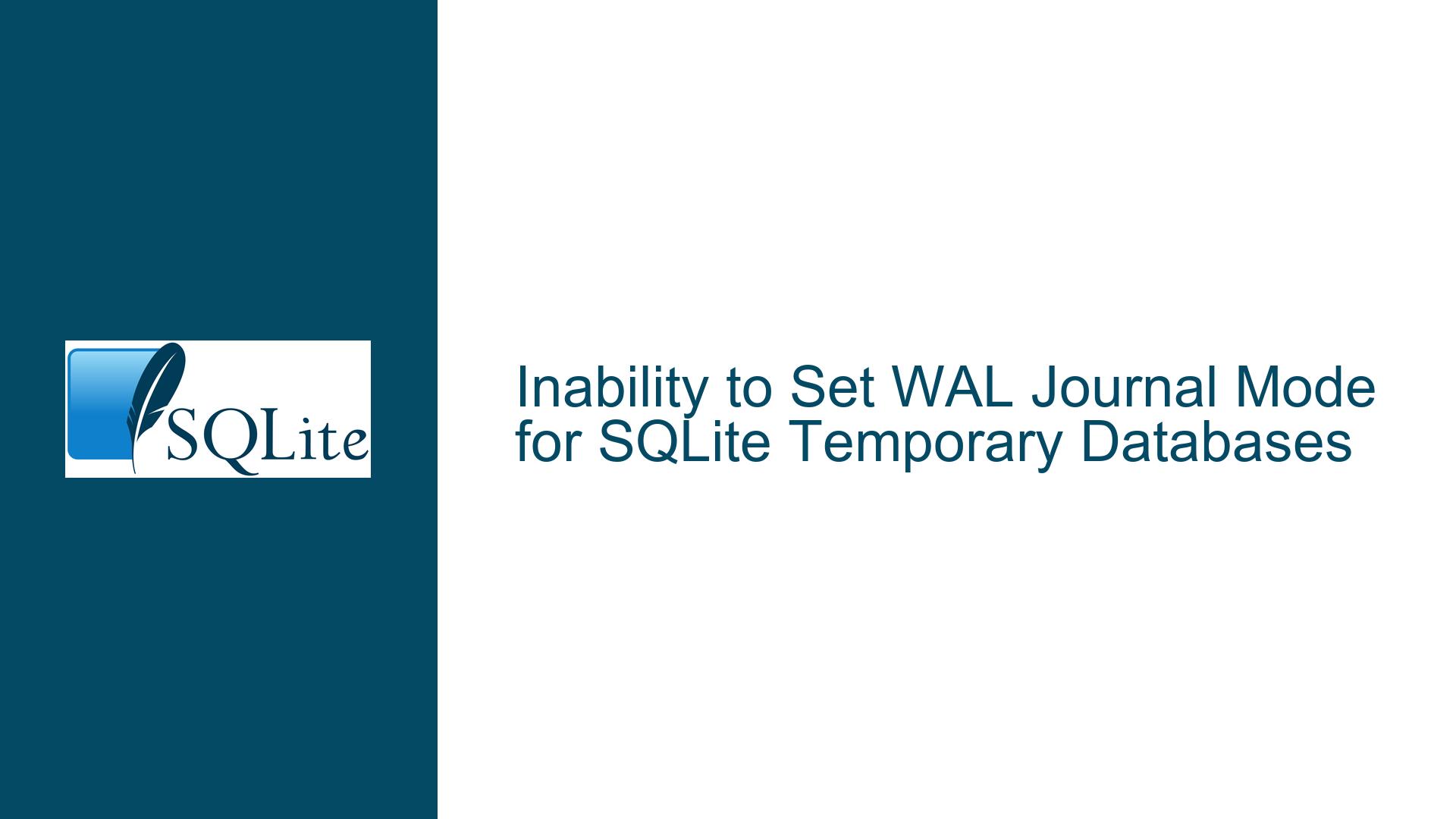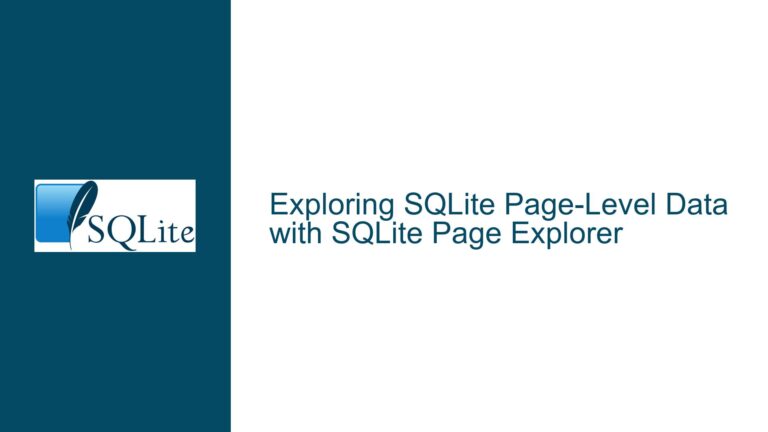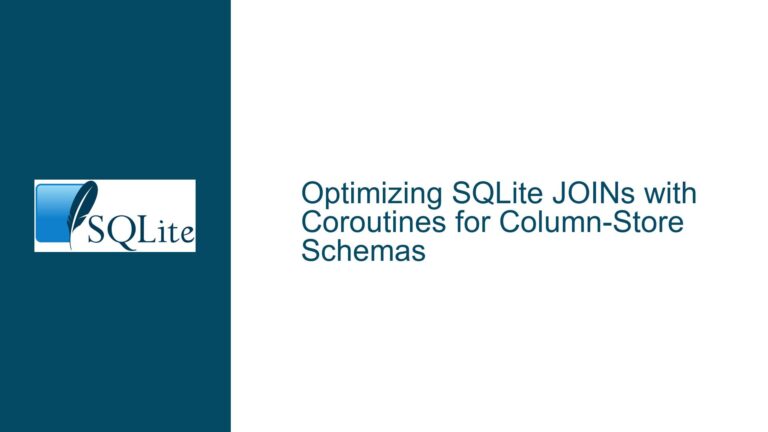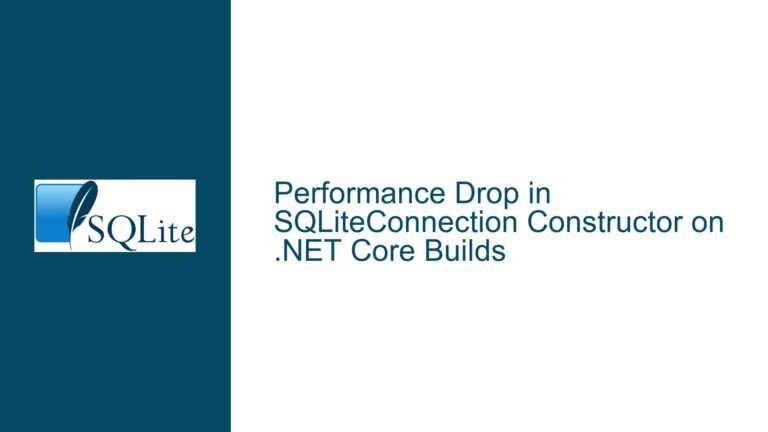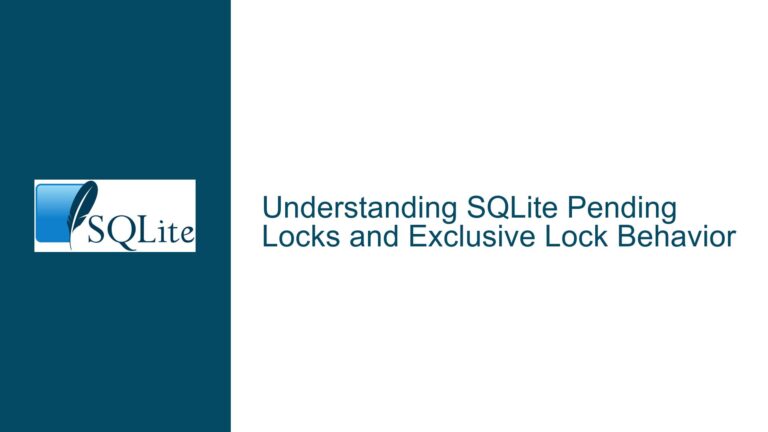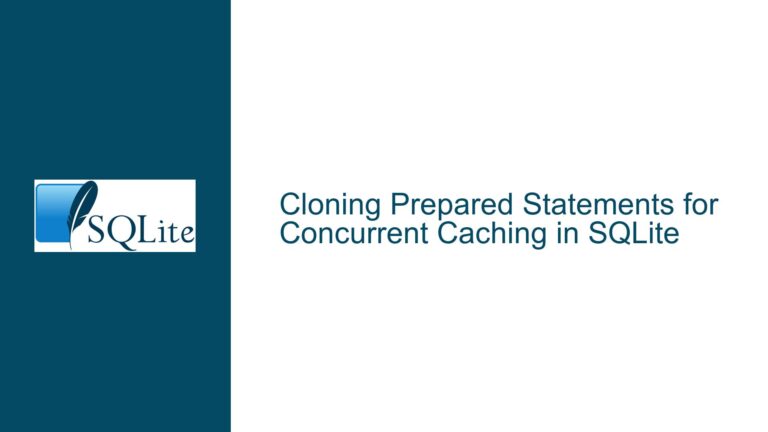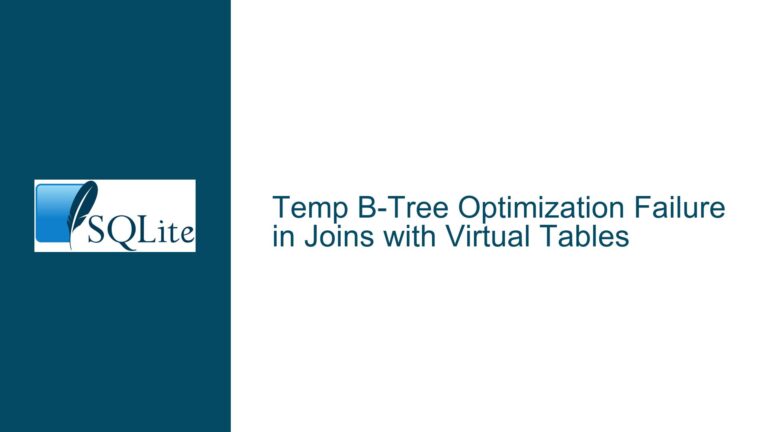Inability to Set WAL Journal Mode for SQLite Temporary Databases
Temporary Database Journal Mode Configuration and Locking Behavior Analysis
Understanding the Core Challenge: Temporary Database Journal Mode Restrictions
The central challenge revolves around configuring SQLite’s temporary databases (opened with an empty filename "") to use Write-Ahead Logging (WAL) journal mode. When a user attempts to set PRAGMA journal_mode=WAL on such a database, the operation silently fails, leaving the journal mode at its default DELETE setting. This occurs even though the explicit goal is not to ensure durability (since temporary databases are transient) but to leverage WAL’s concurrency and locking advantages.
Temporary databases in SQLite are designed for short-lived, session-specific data storage. They may reside in memory or as on-disk files, depending on configuration and platform. By default, temporary databases use DELETE journaling, where rollback journals are created and deleted during transactions. The inability to switch to WAL mode stems from fundamental design constraints in SQLite’s architecture.
The user’s use case involves a library that initializes a temporary database as the MAIN database and attaches other persistent databases as needed. This setup encountered locking conflicts during operations like DROP TABLE on temporary tables, which are blocked by active read statements. The hypothesis was that WAL mode would resolve these conflicts by allowing readers and writers to coexist more gracefully. However, since WAL mode cannot be enabled for temporary databases, alternative approaches must be explored.
Key technical relationships at play:
- Temporary Database Lifetime: Data persists only for the duration of the database connection.
- Attached Databases: Transactions involving multiple attached databases rely on the
MAINdatabase’s journal mode for atomic commits. - Locking Granularity: WAL mode reduces contention by separating readers from writers, but this benefit is irrelevant for databases accessed by only one client.
This issue intersects with SQLite’s transaction management, storage engine behavior, and concurrency model. Understanding these layers is critical for diagnosing the problem and formulating solutions.
Root Causes: Why WAL Mode Is Unavailable for Temporary Databases
1. Single-Client Isolation and Locking Irrelevance
Temporary databases are inherently isolated to the connection that creates them. Unlike persistent databases, they cannot be shared across processes or connections. WAL mode’s primary advantage—allowing concurrent reads and writes across multiple connections—is moot in this context. SQLite optimizes temporary databases by omitting features unnecessary for single-client access, including WAL journaling.
2. Ephemeral Storage and Journaling Overhead
WAL mode requires two persistent files: the -wal write-ahead log and -shm shared-memory file. For temporary databases, which may reside entirely in RAM (e.g., when using :memory: or platform-specific in-memory storage), creating these files is impractical. Even when temporary databases are backed by on-disk files, their transient nature makes WAL’s durability guarantees redundant. SQLite prioritizes simplicity and performance by disabling WAL for such cases.
3. Atomic Commit Limitations Across Attached Databases
When multiple databases are attached to a connection, SQLite uses the MAIN database’s journal mode to coordinate atomic commits. Temporary databases configured with journal_mode=OFF or MEMORY sacrifice atomicity but avoid cross-database synchronization overhead. However, WAL mode introduces additional complexity in managing multi-database transactions, which SQLite disallows for temporary MAIN databases to prevent inconsistent states.
4. PRAGMA journal_mode Enforcement Logic
The PRAGMA journal_mode command internally checks whether the target database is temporary or in-memory. If so, it ignores requests to set WAL mode and silently reverts to DELETE. This behavior is hardcoded in SQLite’s source module pragma.c, where journalModeValid checks exclude WAL for non-persistent databases.
Resolution Strategies: Mitigating Locking Issues Without WAL Mode
Step 1: Diagnose Active Statements Blocking Schema Changes
The DROP TABLE failure described arises from active read statements (e.g., unfinalized SELECT queries) holding locks on the temporary database. To resolve this:
- Finalize or Reset All Prepared Statements: Ensure all
sqlite3_stmtobjects are either finalized withsqlite3_finalize()or reset withsqlite3_reset()before executing schema changes. - Use
sqlite3_unlock_notify(): In multi-threaded environments, leverage unlock notifications to coordinate schema modifications after readers have released locks.
Step 2: Evaluate Journal Mode Alternatives for Temporary Databases
While WAL is unavailable, other journal modes may be suitable:
journal_mode=OFF: Disables rollback journals entirely, reducing I/O overhead. Safe for temporary databases since corruption risks are irrelevant for transient data. Does not affect attached persistent databases.journal_mode=MEMORY: Stores rollback journals in RAM, speeding up transactions at the cost of crash resilience. Suitable for temporary databases where performance outweighs durability.
To configure:
PRAGMA main.journal_mode=OFF; -- For the temporary MAIN database
PRAGMA attached_db.journal_mode=WAL; -- For attached persistent databases
Step 3: Use Named Temporary Databases with Explicit File Paths
Instead of relying on the default temporary database (""), create a named temporary database with a file path. This allows enabling WAL mode if the underlying storage supports it:
.open file:tempdb?mode=memory&cache=shared
PRAGMA journal_mode=WAL; -- Succeeds if the URI format permits file-based WAL
Caveats:
- Platform-specific file locking may still restrict WAL usage for in-memory databases.
- Named temporary databases may persist beyond the connection if not explicitly deleted.
Step 4: Implement Connection-Level Locking Controls
For attached persistent databases, use PRAGMA locking_mode=EXCLUSIVE to minimize lock contention:
ATTACH 'persistent.db' AS persistent;
PRAGMA persistent.locking_mode=EXCLUSIVE;
Exclusive locking mode holds a write lock for the entire session, preventing other connections from accessing the database. This reduces granularity but eliminates lock acquisition overhead.
Step 5: Refactor Schema Design to Minimize Cross-Database Dependencies
Since temporary databases cannot coordinate atomic commits with attached databases, redesign operations to avoid cross-database transactions. Example:
- Isolate Temporary Data: Store transient data exclusively in the temporary database.
- Batch Updates to Persistent Databases: Execute
INSERT/UPDATEoperations on persistent databases in separate transactions.
Step 6: Monitor Performance with Alternative Journal Modes
Benchmark the library’s performance under different configurations:
- Compare
journal_mode=OFF(temporary) +WAL(persistent) against default settings. - Measure the impact of
locking_mode=EXCLUSIVEon write-heavy workloads.
Use SQLite’s sqlite3_profile() function or .timer on in the CLI to gather metrics.
Step 7: Address SQLite Version-Specific Behaviors
Older SQLite versions may impose additional restrictions. Verify the version with SELECT sqlite_version(); and upgrade to 3.35.0+ for:
- Improved handling of
journal_mode=OFFon temporary databases. - Enhanced concurrency in WAL mode for attached persistent databases.
Step 8: Utilize In-Memory Databases for High-Performance Temp Storage
For scenarios requiring WAL-like performance, use :memory: databases with explicit names:
ATTACH 'file:memdb1?mode=memory&cache=shared' AS mem1;
PRAGMA mem1.journal_mode=WAL; -- May fail; fall back to MEMORY if necessary
Shared cache in-memory databases allow cross-connection access, mimicking WAL’s concurrency benefits.
Conclusion: Balancing Performance and Correctness in Temporary Workflows
The inability to enable WAL mode for SQLite’s default temporary databases is a deliberate design choice rooted in their single-client, transient nature. By diagnosing active statement conflicts, adopting alternative journal modes, and refactoring cross-database interactions, developers can mitigate locking issues without relying on WAL. Prioritize journal_mode=OFF for temporary databases to reduce overhead, while reserving WAL for attached persistent databases requiring concurrent access. Always validate configurations against performance benchmarks to ensure optimal behavior in mission-critical applications.
